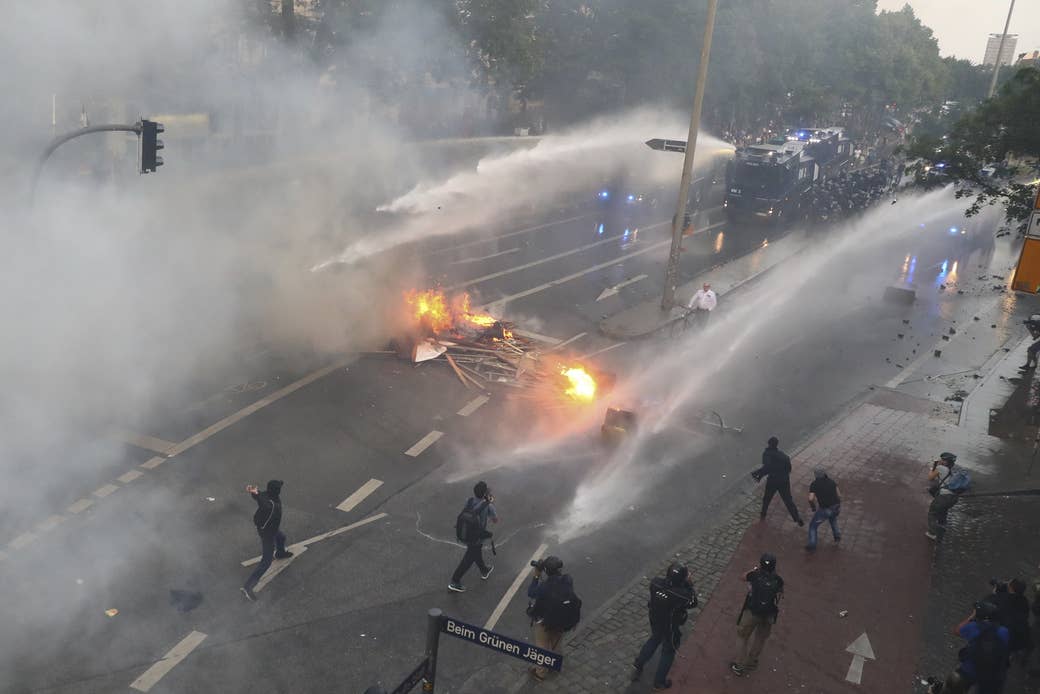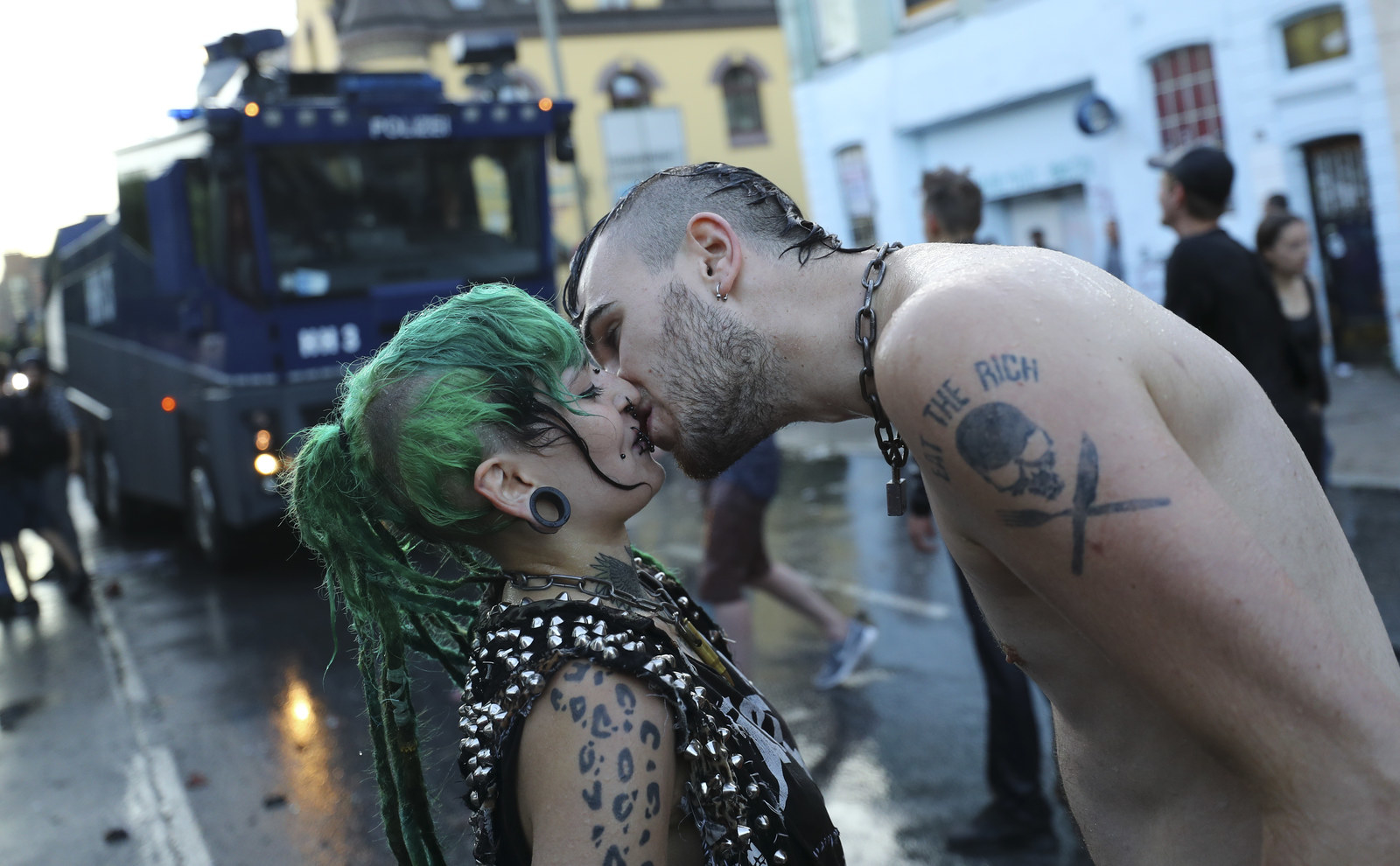
It’s called "The Wasserwerfer,” aka “The Water Thrower,” and it proved decisive in the confrontations between German police and demonstrators during this year’s G20 summit in Hamburg.
For weeks, the radical left and its anarchist allies had been promising a "Welcome to Hell” for the G20, the first time that the leaders of the world’s 20 largest economies had dared to hold their summit in a city since the 2001 debacle in Genoa that left at least one demonstrator dead and scores more seriously hurt.
In the end, though, the thousands of protesters who gathered here were no match for 20,000 German police dispatched from all over the country, with their helicopters, drones, armored vehicles — and “The Wasserwerfer 10,000,” the latest version of mobile water cannon technology, which can propel 10,000 liters of liquid in a blast that dislodges demonstrators, anarchists, and, often, clumsy journalists caught in the crossfire. German police have shortened the name to "WahWeeh 10,000," which when said fast sends them into gales of laughter.
As the self-styled Black Bloc anarchist movement gathered Thursday night to launch its plan to aggressively confront police and capitalism itself, these giant water-belching golems were busy.
Protest trouble had been anticipated since the announcement that the summit would take place in Germany’s wealthiest city. With much of Europe furious at the US's Trump administration for a range of policy and behavior, along with tensions throughout Germany between left and right in the lead up to this year’s elections, there was ample material for protesters.
The prospects seemed grim, from summit organizers’ perspective. The venue for the summit, the city's Messe und Congress convention center, would be just 500 meters from likely protest venues, far different from recent G20s that took place at isolated resorts miles from the nearest city.
And protesters relished the possibilities, skirmishing mildly with riot police in the days ahead of Friday’s summit in what everyone expected was simply a preliminary to the main bout.
On the eve of the summit, the Black Bloc anarchists assembled for their moment. By late Thursday afternoon, hundreds of young men in black jackets, sunglasses, and black hats crushed low over their scarf-obscured faces formed a phalanx to confront the police. Their pockets and backpacks burst with the bottles and road flares they intended to rain down on police.
The vanguard numbered perhaps 1,000. Behind them, an estimated 12,000 protesters assembled for what was billed as a city-wide march against capitalism.
The riot police, however, moved first, flanking the crowd along Hamburg’s waterfront as another police unit cut the Black Bloc vanguard from the rest of the crowd. Anarchy had been kettled. An hour of negotiations ensued, with police insisting the anarchists remove their masks. Then the police charged, firing tear gas and opening the spigots on the massive Wasserwerfers.
The Black Bloc was not so easily undone, however. A hail of beer bottles showered police from the surrounding overpasses, and the Black Bloc protesters, in a preplanned maneuver, folded in on themselves behind large signs that screened them from the police assault. Over a wall they went, escaping the police trap, even as the Wasserwerfers blasted a handful of drunks and final holdouts on the street.

Fleeing into the surrounding areas, the protesters broke into small units that ambushed police and vehicles with bottles, road flares, and rocks until the police flanked them again, behind the irresistible streams from the Wasserwerfers.
The confrontations lasted throughout the night. About 75 police were treated for mostly minor injuries, but officials quietly expressed pleasure that the confrontations hadn’t escalated much beyond vandalism and exchanges of projectiles.
“It was far less dangerous than we expected,” said a commander of heavily armed Federal Police special forces who identified himself only as Captain Gunther. His unit usually conducts military-style raids to resolve hostage situations.
“We had received intelligence that Scandinavian anarchists were coming into Hamburg to join forces with our local Black Bloc,” he said, just meters from the summit venue. “But last night it was mostly just the same local assholes we deal with all the time. Boys playing tough, getting drunk and showing off.”
Friday morning, the protests resumed. In the Hamburg neighborhood of Altona, a group attacked a police station, according to a statement by the German Federal Police, setting multiple cars ablaze. Riot police armed with tear gas, clubs, shields, and water cannons dispersed the crowd, preventing the station from being sacked.
Friday's protests were better organized, with protesters carefully targeting key intersections that participants in the summit would use to reach the Messe und Congress. But they failed in their mission to breach the heavily guarded venue or to trap the summiteers inside.
Demonstrators and police settled into a routine. Black-clad protesters would gather, drawing the police, who’d be met by rocks and bottles from other protesters nearby. Then a different group of police would flank the other protesters and charge into the crowd, knocking people down and raining baton blows on anyone suspected of throwing a rock or a bottle. Arrests seemed rare, with police preferring to spend their energies on maneuvering to keep the protesters from joining up with one another.
Throughout Friday’s mayhem, medics aligned with the protesters treated people for tear gas inhalation, overheating, and, surprisingly, heroin overdoses. Just outside the home stadium of the St. Pauli football club, one demonstrator dressed all in black, his face covered with a mask and sunglasses, collapsed after police stormed in.
“Narcan! I have Narcan! Is it an overdose?” asked a medic as he tried frantically to revive the demonstrator, who appeared to be in his late teens or early twenties. Told that the man had only succumbed to tear gas and not drugs, the medic offered him water and moved on.
“There’s a lot of heroin out here,” the medic said. “At my last count we have used Narcan four times to revive protesters who overdosed.”
Heavy drinking and marijuana gave the crowds a bizarre party atmosphere — as well as an endless stream of empty bottles to throw at police. Hamburg’s Reeperbahn red light district took on a surreal feel Friday night as smartly dressed couples and tourists hit bars, pubs, and strip clubs amid water cannons, tear gas, and burning road flares thrown at police lines.
For the men selling marijuana (real) and grams of cocaine (fake) to tourists, the demonstrations offered a welcome break from the usual police attention to their operations.
“Are they demonstrators or British tourists? I don’t really care, if they have money,” said Philippe, 21, from Senegal, who said he crossed the Mediterranean last year from Libya to get into the EU as a refugee.
“It just feels like a normal party night but with more helicopters,” he joked.


